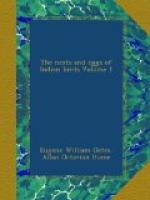From Sambhur Mr. R.M. Adam tells us:—“This Raven is pretty common during the cold weather, but pairs are seen about here throughout the year. They are very fond of attaching themselves to the camps of the numerous parties of Banjaras who visit the lake.
“I obtained a nest at the end of January which contained three eggs, and a fourth was found in the parent bird. The nest was about 15 feet from the ground in a Kaggera tree (Acacia leucophloea) which stood on a bare sandy waste with no other tree within half a mile in any direction.”
The eggs of the Punjab bird are, as might be expected, much the same as those of the European Raven. In shape they are moderately broad ovals, a good deal pointed towards the small end, but, as in the Oriole, greatly elongated varieties are very common, and short globular ones almost unknown. The texture of the egg is close and hard, but they usually exhibit little or no gloss. In the colour of the ground, as well as in the colour, extent, and character of the markings, the eggs vary surprisingly. The ground-colour is in some a clear pale greenish blue; in others pale blue; in others a dingy olive; and in others again a pale stone-colour. The markings are blackish brown, sepia and olive-brown, and rather pale inky purple. Some have the markings small, sharply defined, and thinly sprinkled: others are extensively blotched and streakily clouded; others are freckled or smeared over the entire surface, so as to leave but little, if any, of the ground-colour visible. Often several styles of marking and shades of colouring are combined in the same egg. Almost each nest of eggs exhibits some peculiarity, and varieties are endless. With sixty or seventy eggs before one, it is easy to pick out in almost every case all the eggs that belong to the same nest, and this is a peculiarity that I have observed in the eggs of many members of this family. All the eggs out of the same nest usually closely resemble each other, while almost any two eggs out of different nests are markedly dissimilar.
They vary from 1.72 to 2.25 in length, and from 1.2 to 1.37 in width; but the average of seventy-two eggs measured is 1.94 by 1.31.
Mandelli’s men found four eggs of the larger Sikhim bird in Native Sikhim, high up towards the snows, where they were shooting Blood-Pheasants.
These eggs are long ovals, considerably pointed towards one end; the shell is strong and firm, and has scarcely any gloss. The ground-colour is pale bluish green, and the eggs are smudged and clouded all over with pale sepia; on the top of the eggs there are a few small spots and streaks of deep brownish black. They were found on the 5th March, and vary in length from 1.83 to 1.96, in breadth from 1.18 to 1.25.
3. Corvus corone, Linn. The Carrion-Crow.
Corvus corone, Linn., Jerd. B. Ind. ii,
p. 295; Hume, Rough Draft
N. & E. no. 659[A].




